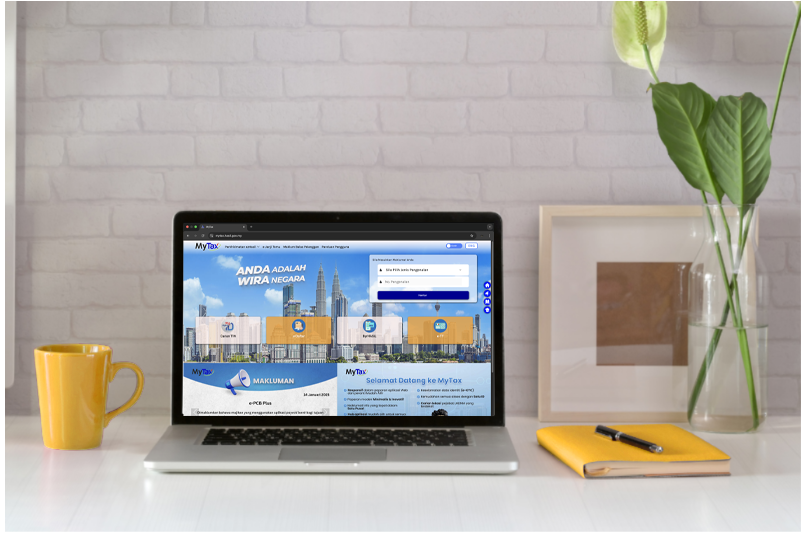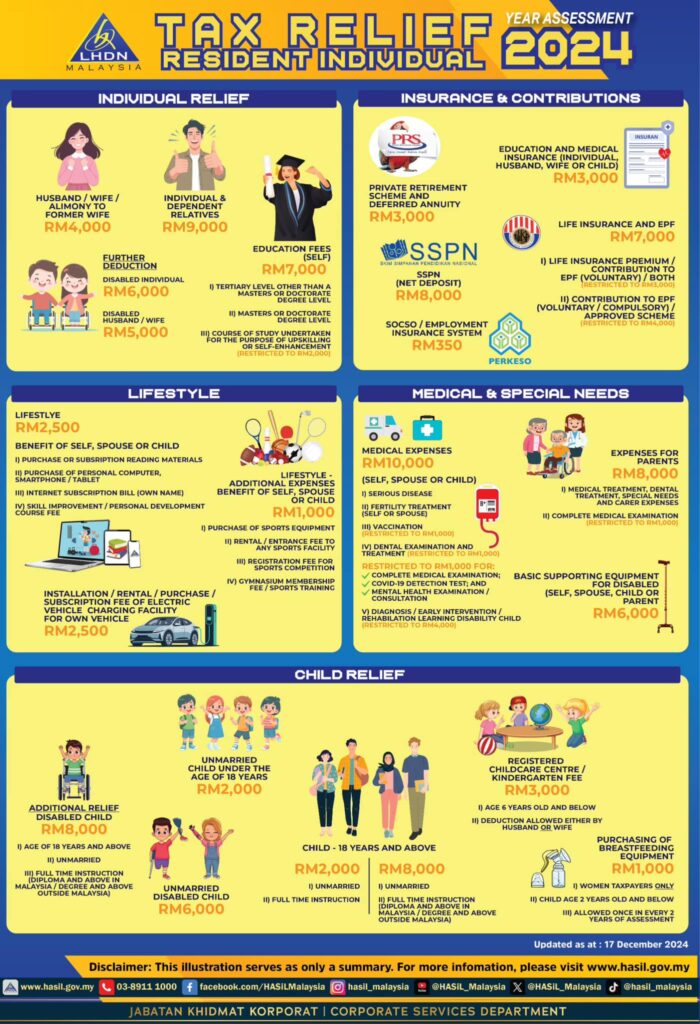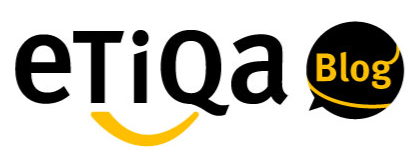How to Get the Maximum Tax Refund in Malaysia? A Guide to Income Tax Filing in 2025 (YA 2024)

April’s almost over, which means the deadline to file your income tax is coming up soon! Love it or dread it, you’ve got to do it. Filing your income tax is less of a chore when you know how to get the maximum tax refund!
While most tax deductibles are somewhat standard through the years, there are slight changes that may be beneficial to you. To help you better understand your deductible options and see what’s new, this guide is for you.
How to Set Up e-Filing?
Before you begin, check if you qualify as an income taxpayer. According to the Inland Revenue Board or Lembaga Hasil Dalam Negeri (LHDN), you need to pay and file your taxes if you earn at least RM37,333 annually or about RM3,111 per month, after your Employees Provident Fund (EPF) deductions.
Meet the minimum income requirement? Set up your e-Filing account in three steps:
Step 1: Register for a Tax Identification Number (TIN) on the MyTax website. Click on e-Daftar, fill in the required details, and submit the form. You’ll then receive your TIN via email within a few days.
Step 2: Once you get your TIN, return to the MyTax website and log in using your TIN. Choose First Time Login and follow the instructions to create your login details.
Step 3: Select the correct tax form based on your income source(s). For individuals, this typically involves selecting between:
- Form BE: Without business source of income (For individuals earning solely from employment)
- Form B: With business source of income (For individuals with business, freelance, or additional income sources)
After completing the steps above, double-check and update your information, including your personal details, banking information, and employee information. Under the income declaration section, copy the information provided in your EA form (obtained from your employer).
If you have multiple streams of income, don’t forget to add them up and declare them as well. This would include freelance jobs, side hustles, property rentals, and other relevant income sources.
ProTip: If you have multiple full-time jobs in 2024, request your EA forms from all the companies and add up the sum of income, tax deductions, and other required information.
How to Get the Maximum Tax Refund? Claim Your Tax Reliefs!
To maximise your tax refunds, be sure to claim all tax reliefs that are applicable to you and which you have kept receipts for. These reliefs reduce your taxable income, which in turn lowers the amount of tax you need to pay. Go through all the available tax reliefs in 2024 so you’re aware of what’s available and where to input your expenses. Here are the available items and their limits:
Self, Spouse, and Dependent Relatives
- Automated individual and dependent relatives’ entitlement of RM9,000 – This is automatically provided in your online form
- Care for disabled spouse, RM5,000
- Disabled individual, RM6,000
- Husband/wife/alimony payment to ex-wife (limited to RM4,000)
Medical and Special Needs
- Medical, dental treatment, special needs and carer expenses for your parents are claimable up to RM8,000, with a sub-limit of RM1,000 for a complete medical examination for your parents
- Any supporting equipment for a disabled parent, spouse, child, or self, up to RM6,000
- Medical expenses for self, spouse, or child up to RM10,000. This includes:
- Treatments for serious illnesses
- Fertility treatments
- Vaccinations, up to RM1,000
- Dental examinations and treatments (limited to RM1,000)
- Full medical check-ups, COVID-19 tests (inclusive of RTK home kits), and mental health examinations or consultations are claimable up to RM1,000
- Diagnosis, early intervention, and rehabilitation for learning disabilities for children aged 18 and below (restricted to RM4,000)
Education for Self
If you have upskilled yourself in 2024, you would be entitled to a total tax relief of up to RM7,000. This primarily focuses on Bachelor’s, Master’s, and Doctorate degrees. However, there is a tax relief option for any course taken for the purpose of upskilling and self-enhancements, with a sub-limit of RM2,000.
Lifestyle Reliefs for Self, Spouse, Or Child
If you’ve been wondering how to get the maximum tax refund, here’s a category that’s especially useful for many! Lifestyle expenses are tax deductible up to RM2,500. This includes any of the following items:
- Books, journals, magazines or any digital subscriptions that offer reading materials
- A personal computer, laptop, tablet, or smartphone
- Sports equipment or gym memberships
- Home internet bills – don’t forget, the bills need to be in your own name!
Additional Lifestyle Reliefs for Self, Spouse, or Child
- Sports equipment, gym memberships, sports trainings, rental or entrance fees to sports facilities, or registration fees for sports competitions, up to RM 1,000
- Purchase, installation, or rental of electric vehicle (EV) charging equipment for personal use, up to RM2,500
ProTip: Use the first lifestyle column to claim your internet bill and reading materials, so you can save your sports receipts to be claimed under its individual section. Additionally, seeing that reading materials have a high limit, it’s a good excuse to pick up a book habit or subscribe to online news portals this year!
Parental Benefits
- Breastfeeding equipment for own use for child aged 2 and below, up to RM1,000 (Deduction allowed once every TWO (2) years)
- Child care fees for registered daycare centres or kindergartens for children aged 6 and below, up to RM3,000
- Net deposit in SSPN – Parents who have invested in Skim Simpanan Pendidikan Nasional (SSPN) are eligible for a tax relief of up to RM8,000
- Child under 18, unmarried – Parents are eligible for a tax relief of up to RM2,000 for every child unmarried under the age of 18. Do note that if parents file their taxes separately, only one parent is allowed to claim the deductible per child
- Child above 18, studying, unmarried – Parents are eligible for a tax relief of up to RM2,000 for children in pre-university courses and RM8,000 for children undertaking a diploma or higher qualification in Malaysia or a bachelor’s degree or higher qualification outside Malaysia. This deductible is only valid if the course and institution is recognised by Malaysia’s Ministry of Education
- Unmarried disabled child – Parents are eligible for a tax relief of up to RM6,000.
- Unmarried disabled child, aged 18 and above, studying – An additional RM8,000 tax relief can be claimed for an unmarried disabled child, aged 18 and above, pursuing a diploma or higher qualification in Malaysia or a bachelor’s degree or higher qualification outside Malaysia. This is only valid for courses and institutions recognised by Malaysia’s Ministry of Education.
Finances – Insurance, Takaful, and Investments
- Life insurance, family takaful, or additional voluntary contributions to EPF have a tax relief of up to RM3,000 per annum. However, retired public workers have a limit of up to RM7,000 per annum but do not qualify for EPF deductions as per below
- Mandatory or voluntary contributions to the EPF or other approved schemes have a relief of up to RM4,000
- Private Retirement Scheme (PRS) and deferred annuity contributions are eligible for a tax relief of up to RM3,000
- Education and medical insurance or takaful for self, spouse or children have a relief of up to RM3,000
- Contribution to the Social Security Organisation (SOCSO) is claimable up to RM350
Rebates
- Departure levy (taxes/fees) for umrah or other recognised religious pilgrimages, up to RM150 per trip, limited to 2 trips per lifetime.
- Total payment for zakat or zakat fitrah
When filing your taxes, don’t forget that you must have proof of expenses, whether it’s a physical receipt or a digital copy. You are required to keep these receipts for up to 7 years, during which LDHN may have random audits and can request proof of payments at any time.
ProTip: Just in case you missed it, if you’ve made a purchase online, don’t forget to download the receipts and add them to your claims. This includes receipts for RTK test kits, books, magazines, or sports equipment for those home workouts!

When Do I Submit My Income Tax Filing?
Don’t miss the deadline! The due dates for filing individual income tax are as follows:
| Category | Manual Filing | Online Filing (e-Filing) |
| Residents without business source of income (filing the BE Form) | 30 April 2025 | 15 May 2025 |
| Residents with business source of income (filing the B Form) | 30 June 2025 | 15 July 2025 |
Final ProTip: File your income tax as soon as possible. The earlier you submit your form, the faster you get your returns. Besides, that last-minute scramble to make the deadline just means you might miss out on a claim or two.
In the end, knowing how to get the maximum tax refund comes down to being well-prepared, understanding your eligible reliefs, and giving yourself enough time to file accurately.
The information contained in this blog is provided for informational purposes only. It should not be construed as advice on any matter. Etiqa accepts no responsibility for loss which may arise from reliance on information contained in this article. This information is correct as of 29 April 2025.
Sources:
Lembaga Hasil Dalam Negeri (LHDN) (1, 2); RinggitPlus (1, 2)
